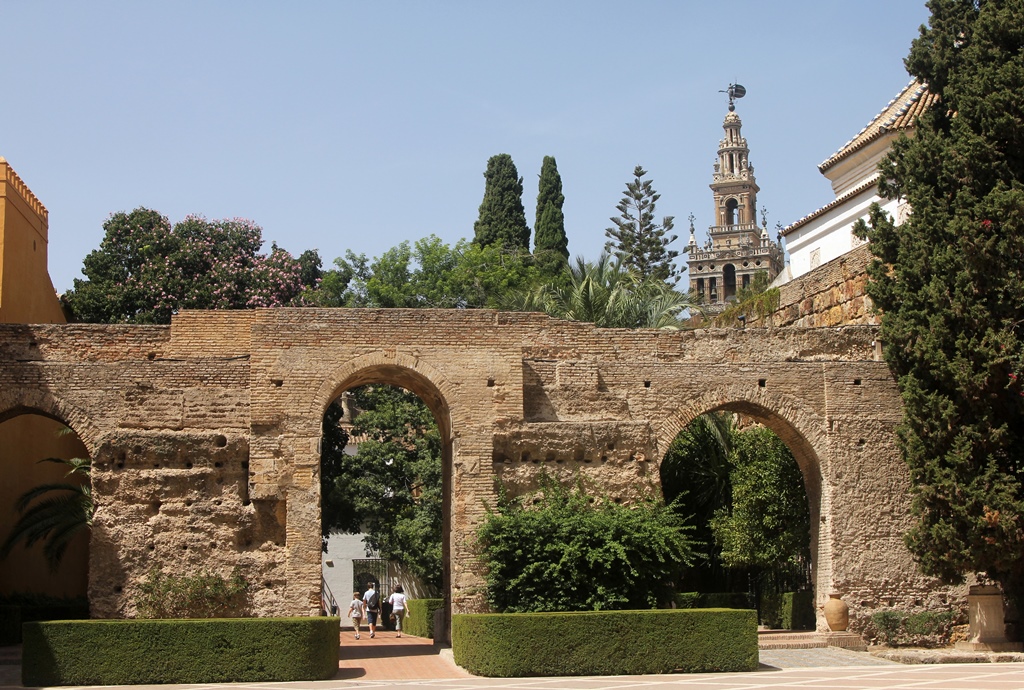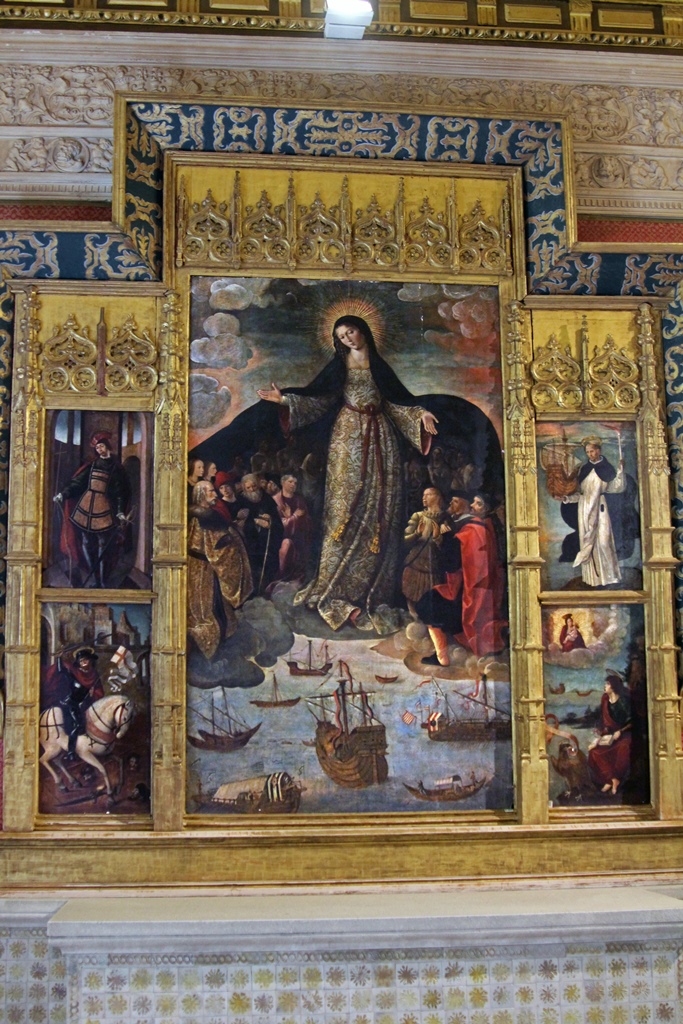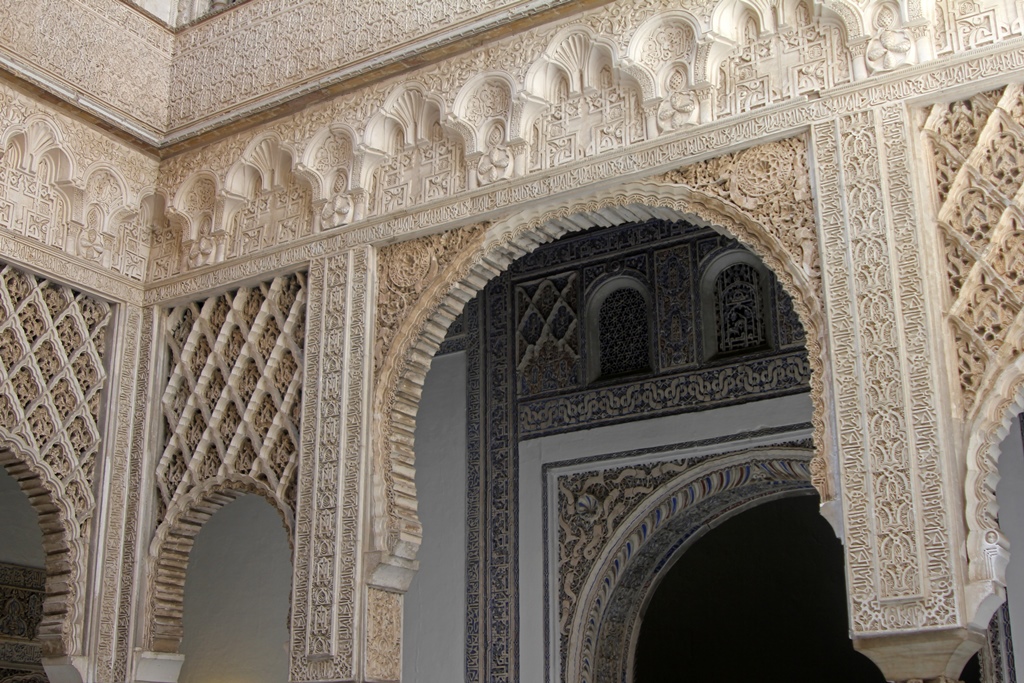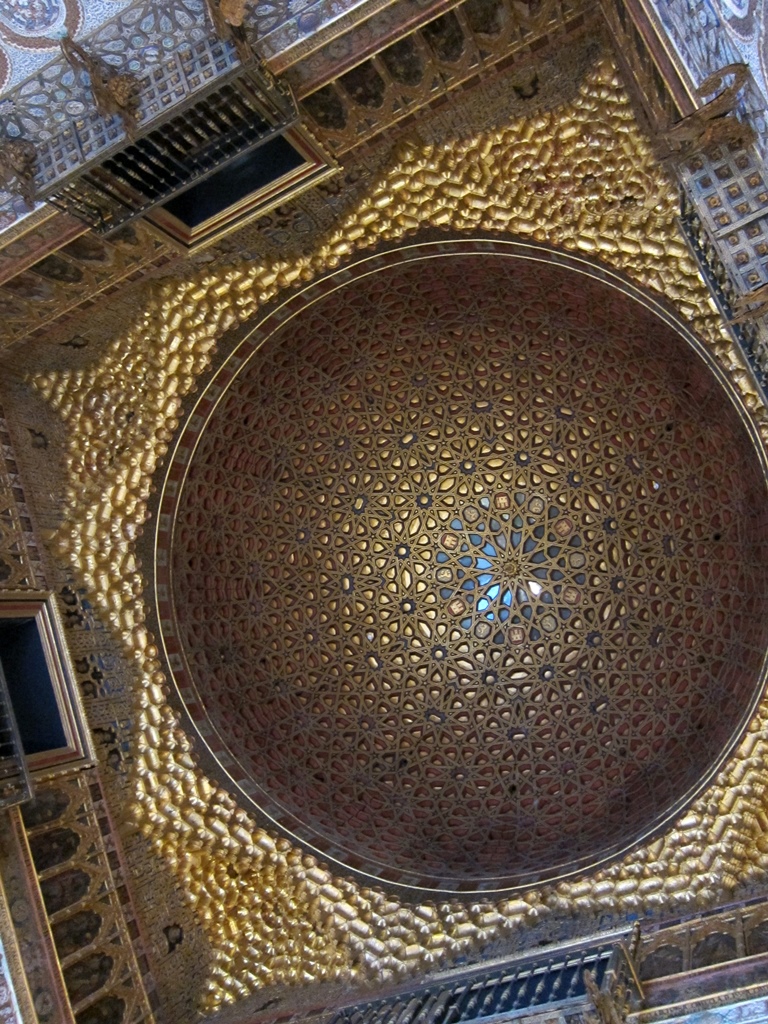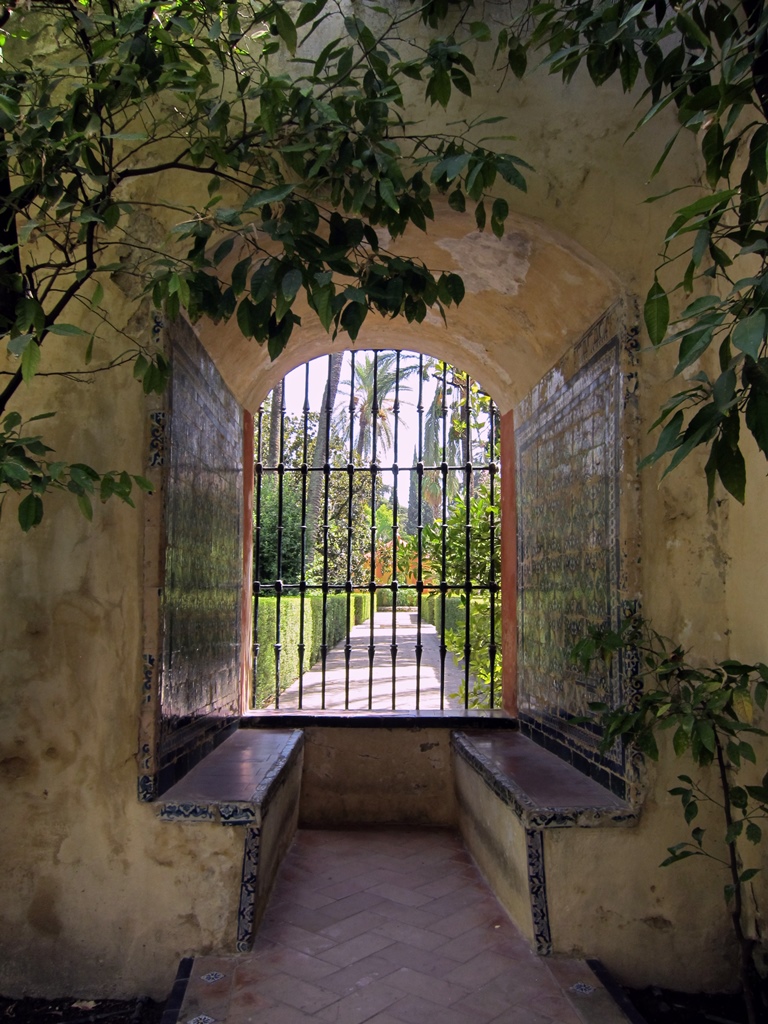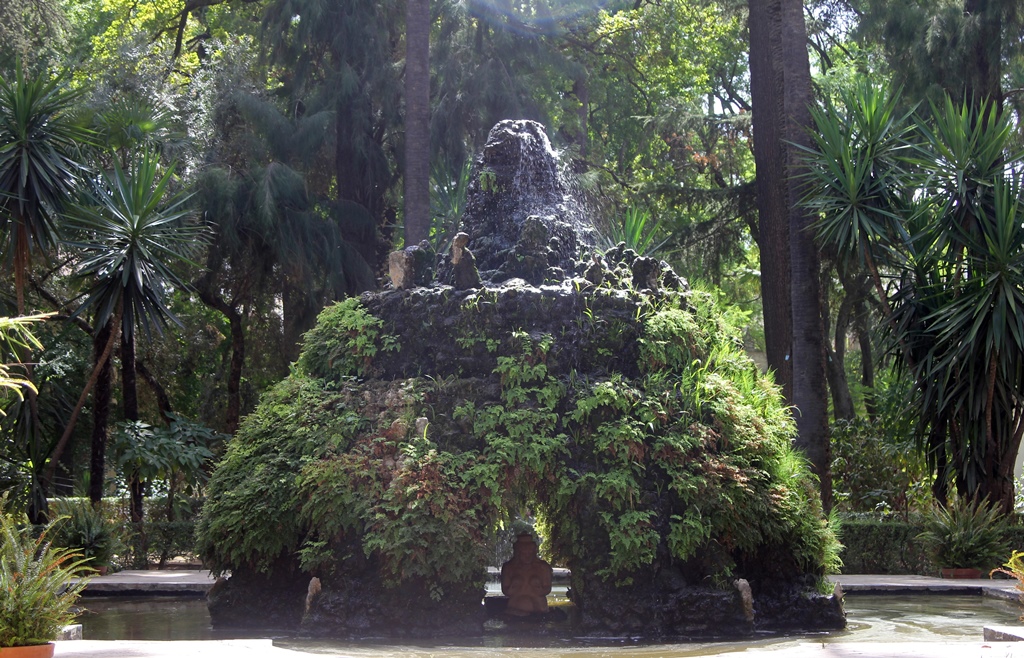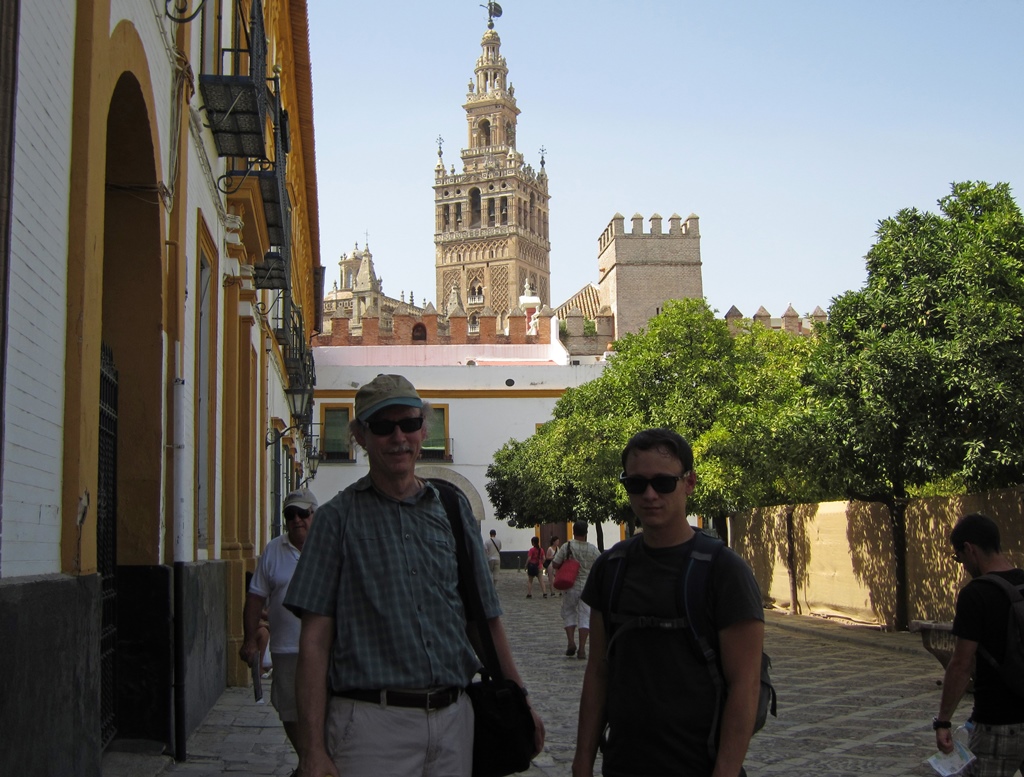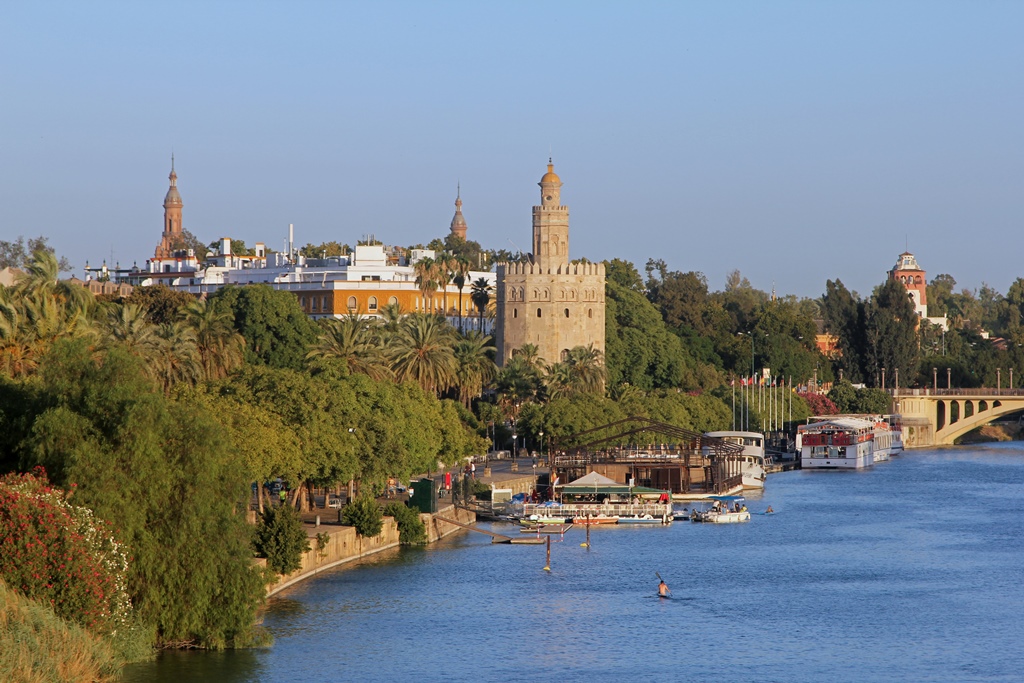The Alcázar of Seville
(Reales Alcázares de Sevilla) is a complex of palaces, courtyards and
gardens that dates back to the Moorish days of the 11th Century, well before the Christian conquest
of the city in 1248. Despite the Middle Eastern appearance of many of the Alcázar's elements,
little remains within the outer walls of any original Moorish structures, with a succession of
Castilian monarchs having left their imprints on the complex. Castilian and Spanish royals have
spent time here since the Reconquista, and even the present-day royal family uses one of the
palaces as an occasional residence. On other occasions the Alcázar shows up in motion pictures as
some exotic location or other. Present-day followers of Game of Thrones may recognize parts
of it as the Water Gardens of Dorne, a residence of House Martell (featured in Season 5). But the
Alcázar is mostly a point of interest for tourists, including us, twice (see
the page for our previous visit).
The entrance to the Alcázar is on the Plaza del Triunfo, through the distinctive Lion Gateway.

Bob and Philip and Alcázar Entrance
After paying for admission, a visitor passes through a courtyard called the Lion's Courtyard,
eventually encountering a fragment of an original Moorish wall, with arches.
Fragment of Almohad Wall, with Giralda
On the other side of the wall is a large courtyard (called the Hunting Courtyard), on the far side
of which is a large palace called the Palace of Pedro I.
Hunting Courtyard and Palace of Pedro I
We didn't go into this palace immediately, opting to first explore the structure to our right,
a building in which the Spanish House of Trade was founded. The House of Trade (Casa de
Contratación) was an agency established by Queen Isabella in 1503 to manage colonization and
trade that was occurring as a result of Spanish exploration, as well as the planning of the
expeditions themselves. Some expeditions actually used the nearby Guadalquivir River to get to
the sea. One of the House's early officers was the Florentine explorer Amerigo Vespucci (after
whom America was named), who worked as the organization's Chief of Navigation from 1508 until
his death in 1512. Prior to the establishment of the agency, the Queen had used the Alcázar
structure for exploration-related purposes, including a meeting with Christopher Columbus
following his second voyage to the New World (still thought to be the East Indies), in 1496.
The House operated from Seville until 1717, when it was moved to Cádiz. The building now houses
displays of fans and tiles, plus a chapel in which divine guidance/assistance was once requested
for the organization's various endeavors.
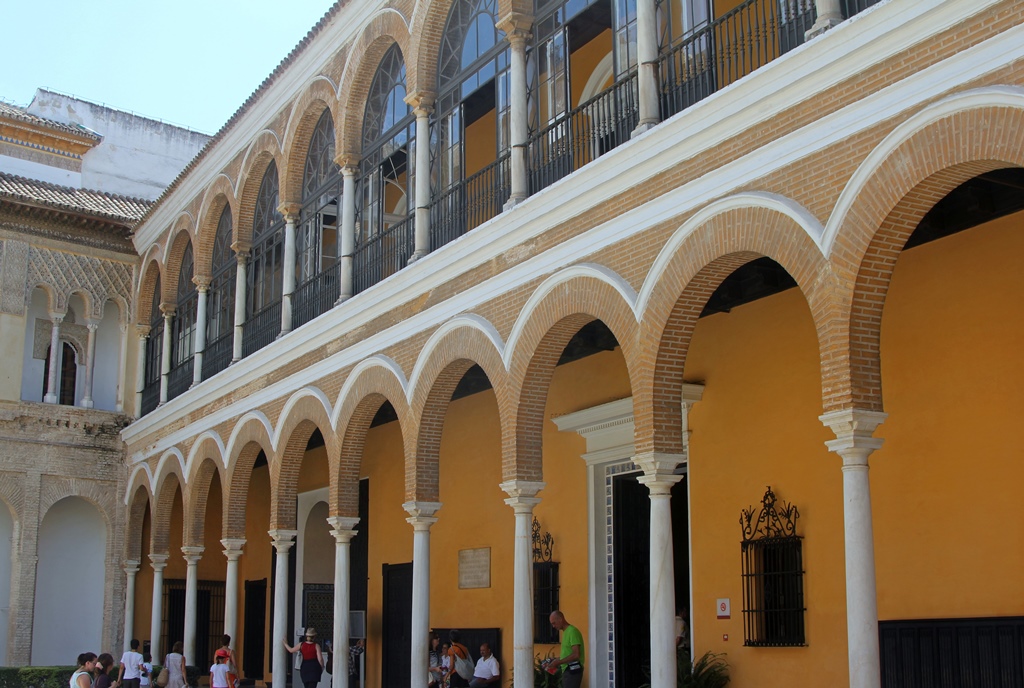
House of Trade Building
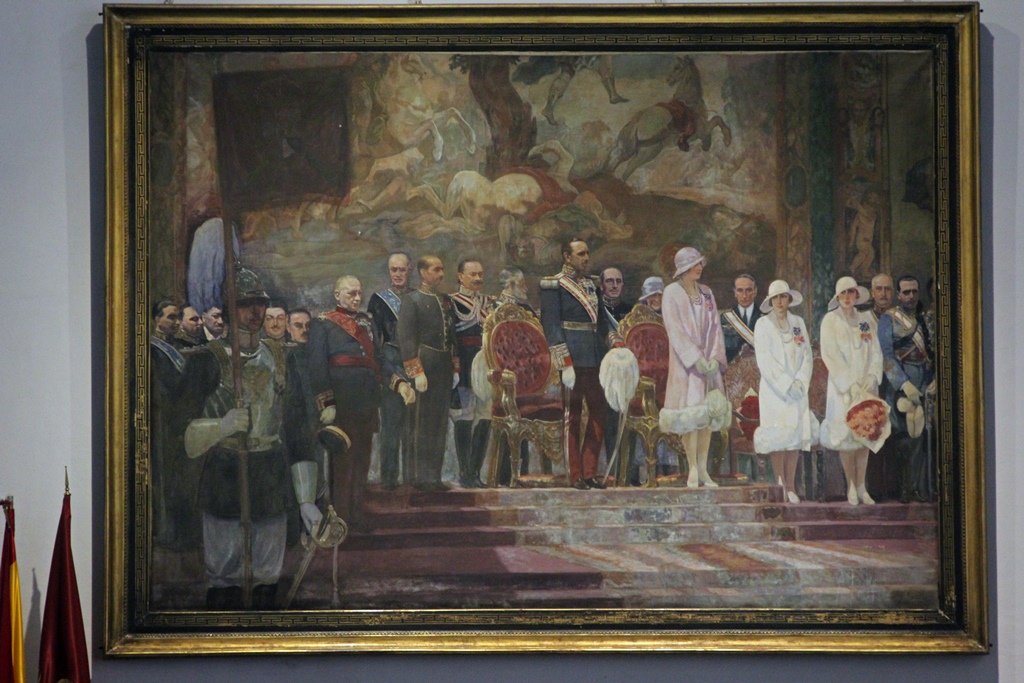
Painting of Royal Family (20th C.)
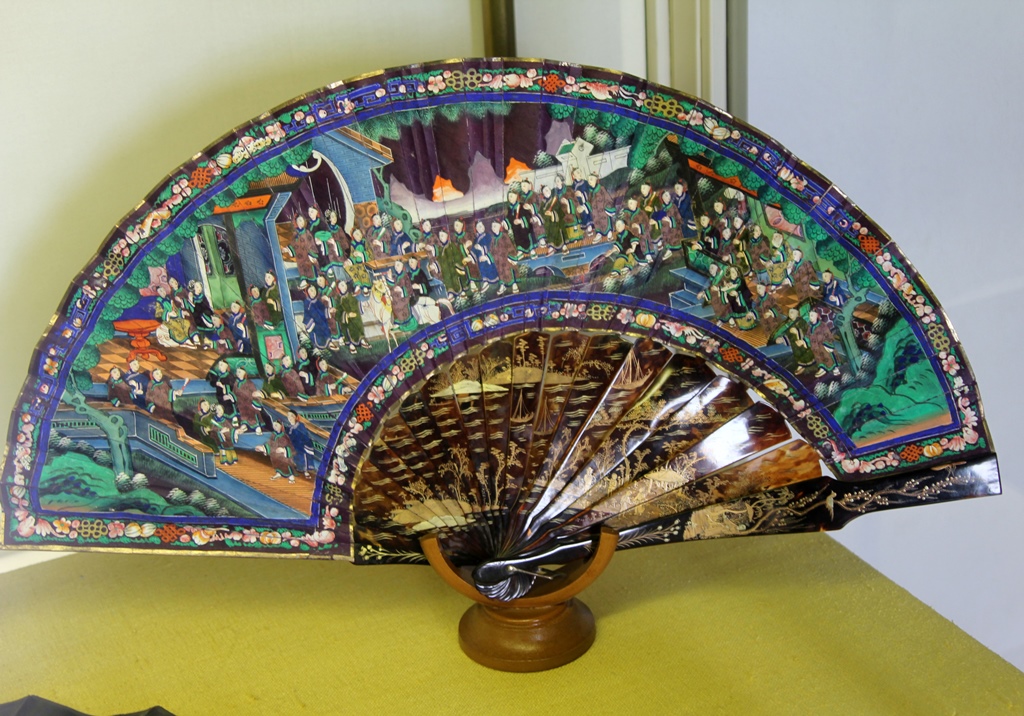
Oriental Asymmetrical Fan
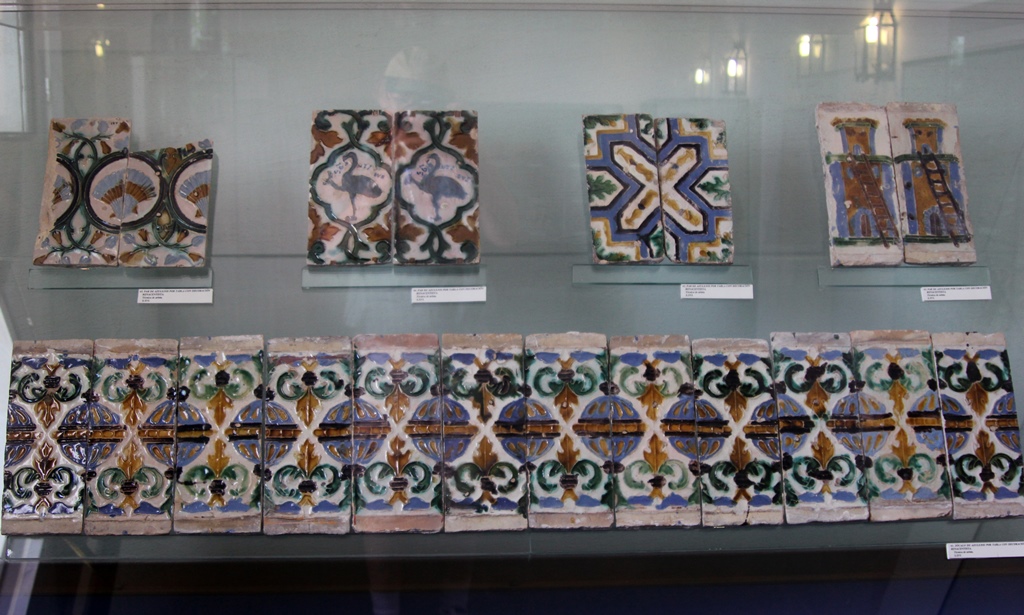
Tiles
Virgen de los Mareantes Altarpiece (1535)
We left the House of Trade building and walked over to the Palace of Pedro I. This palace
consists of two stories, but we were only able to visit the ground-level floor. The top floor
is off limits to mere tourists such as us, as this is the part of the Alcázar which is sometimes
used as a residence by the royal family.
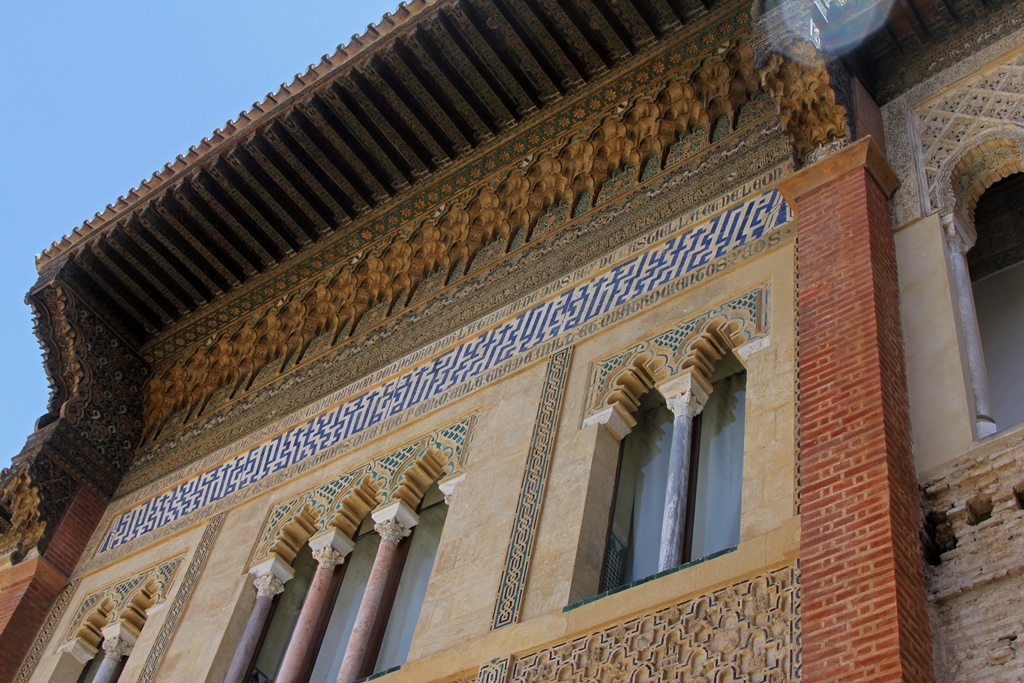
Detail, Palace of Pedro I
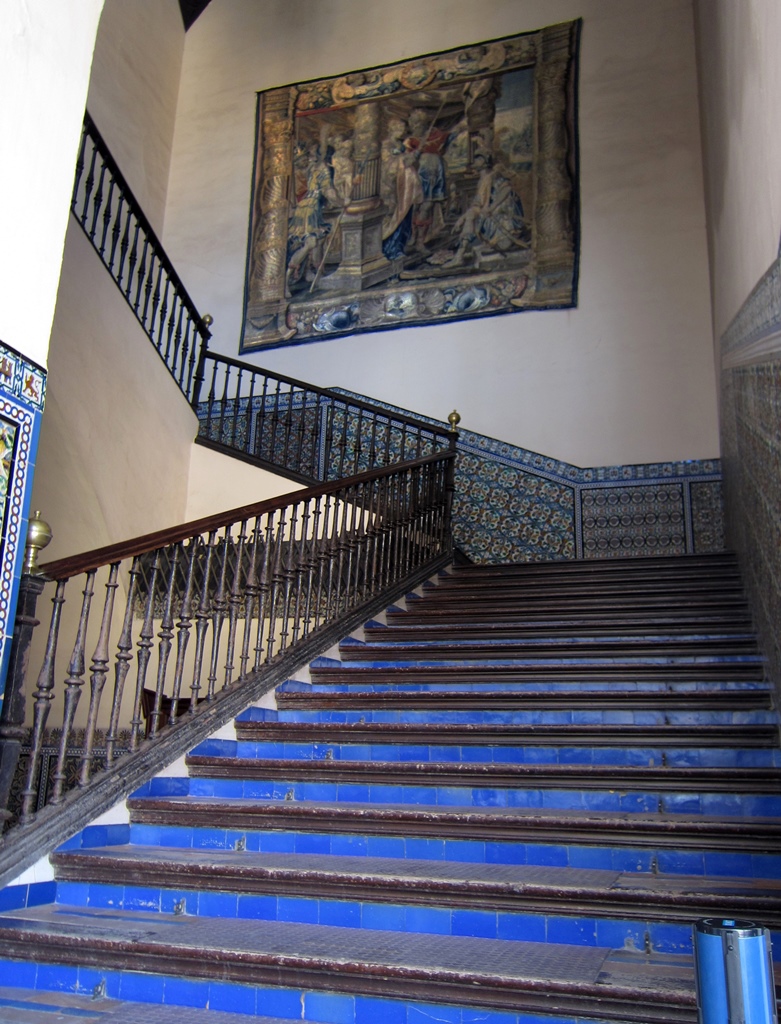
Stairway to Upper Palace
Pedro I (or Peter I, for those uncomfortable with the español) ruled Castile and León
between 1350 and 1369 (with a short break in 1366-67), and had the palace built between 1364 and
1366. It's hard to know what to think about Pedro, as supporters and detractors have passed
seemingly contradictory accounts down through the centuries. Depending on whom you choose to believe,
he has become known as either Pedro the Cruel (because of many murders he is supposed to have ordered)
or Pedro the Just (by those who maintain the murder thing to be exaggerated, and celebrate the security
enjoyed by the people under his rule). He was apparently more just to his Jewish subjects than other
rulers of that era were. The English were allied with him and still have a positive view of him – Geoffrey
Chaucer visited Castile during his reign and mentioned Pedro's death in mournful terms in The Canterbury
Tales. His 1369 death was pretty dramatic – apparently his half-brother and successor Henry of
Trastámara unexpectedly stabbed him in the face and elsewhere repeatedly, leaving his body unburied for
three days so it could be subjected to ridicule and abuse (maybe there should have been a Henry the Cruel).
Pedro left six offspring, by three different women. And he left a pretty cool palace in Seville.
The Palace of Pedro I was built at roughly the same time as some of the Nasrid palaces at the Alhambra in
Granada, and shows some stylistic similarities. Not surprising, as Pedro actually had an alliance with
the Sultan in Granada, and used some artists from that kingdom (in addition to others from Seville and
Toledo) in the building of his palace. The style, a mix of Gothic and Islamic, is known as Mudejar.
The palace consists of several smallish, highly-decorated, interconnected rooms surrounding two courtyards
or patios. The courtyards are much smaller than the larger courtyards at the Alhambra. The smaller one
is called the Dolls' Courtyard, and the larger one, which has a long reflecting pool, is known as either the
Damsels' Courtyard or the Maidens' Courtyard.
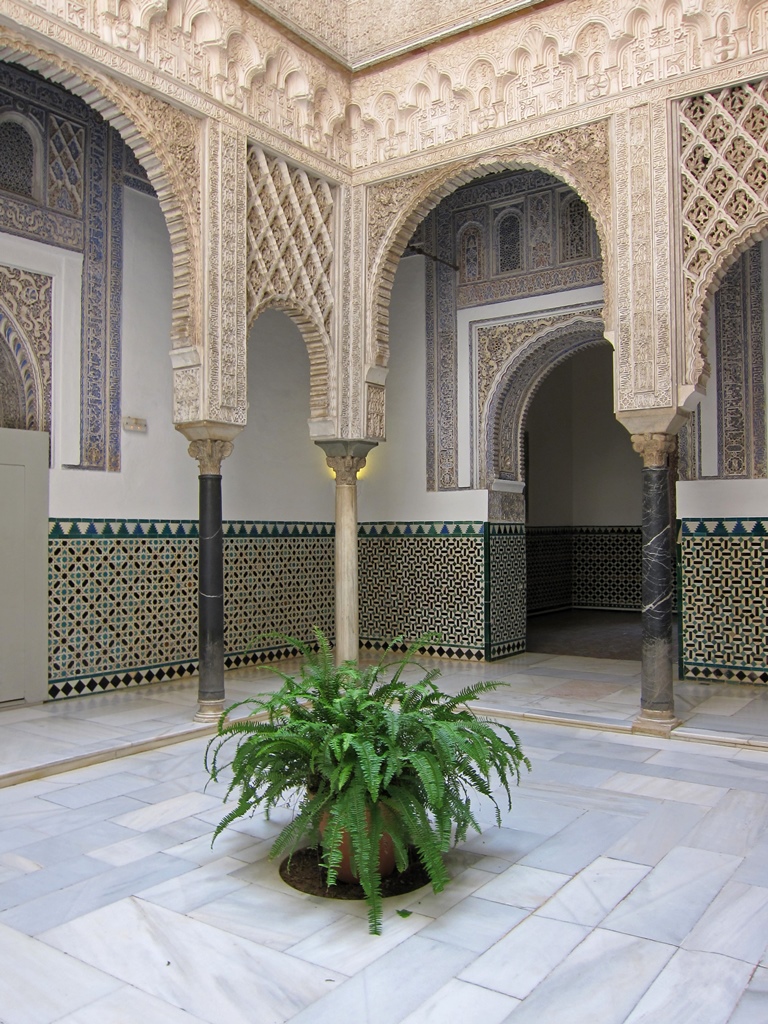
The Dolls' Courtyard
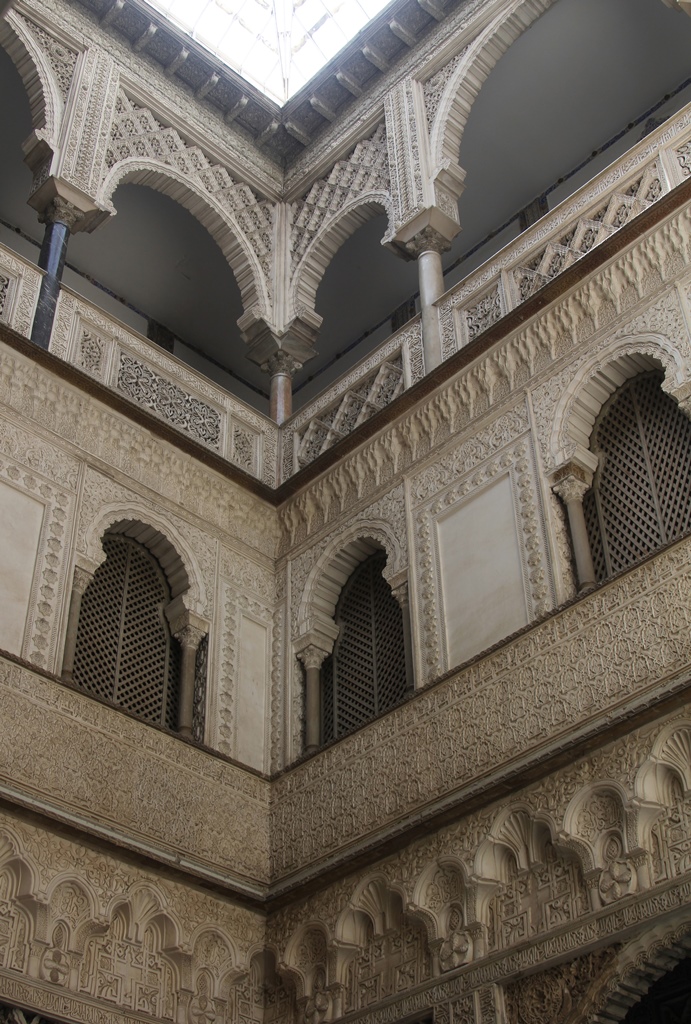
The Dolls' Courtyard
Arches, Dolls' Courtyard

The Damsels' Courtyard
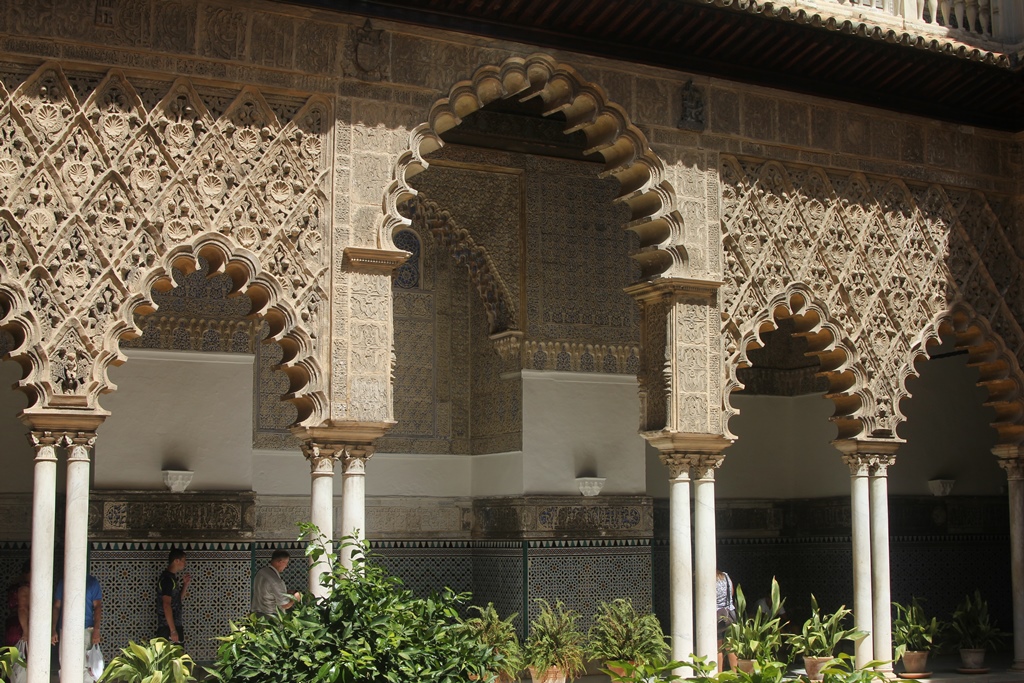
Arches, Damsels' Courtyard
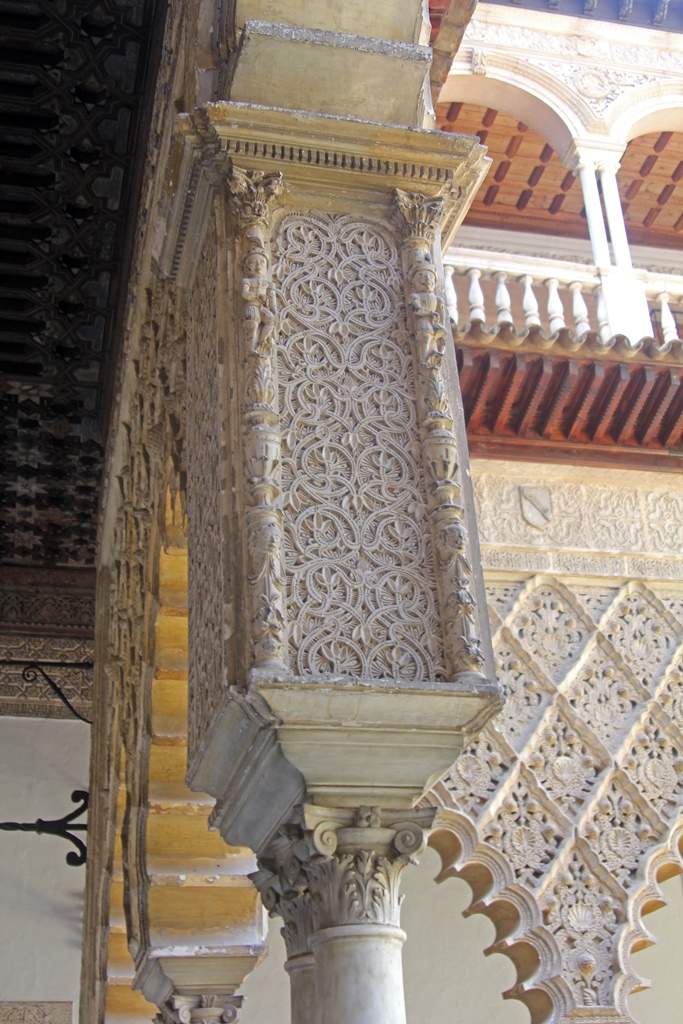
Column Detail, Damsels' Courtyard

Ceiling, Damsels' Courtyard Gallery
The surrounding rooms have doorways into the courtyards. Some also have views outward, into
some of the Alcázar's gardens (more on these later).

Door Toward Prince's Garden
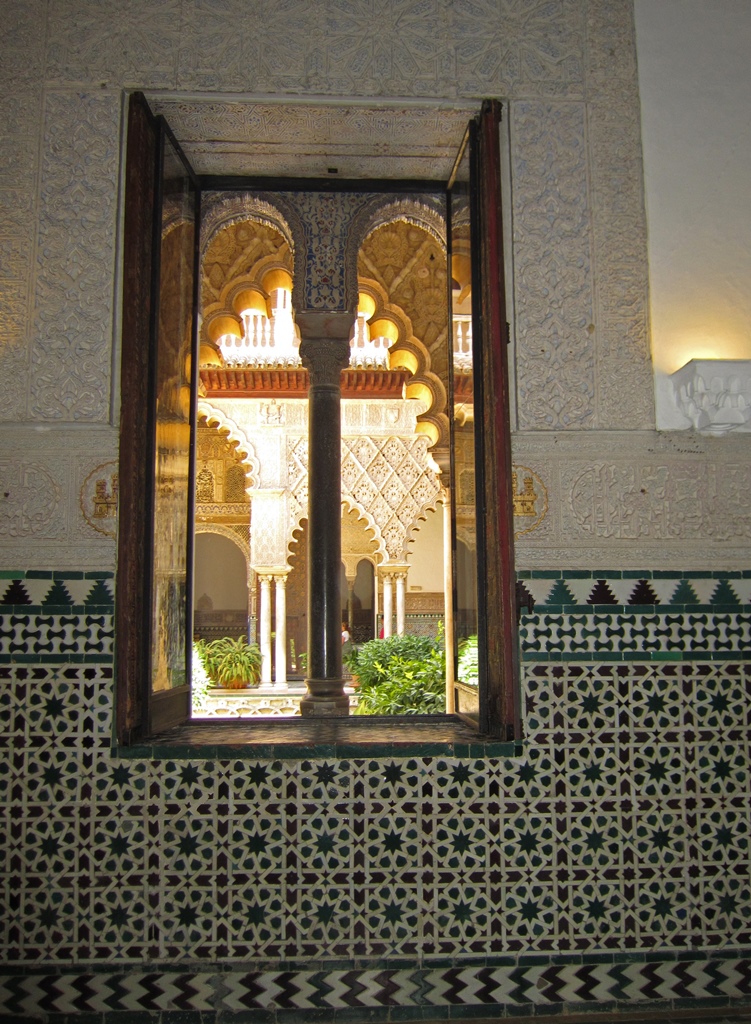
Window, Royal Alcove

Decoration, Royal Alcove
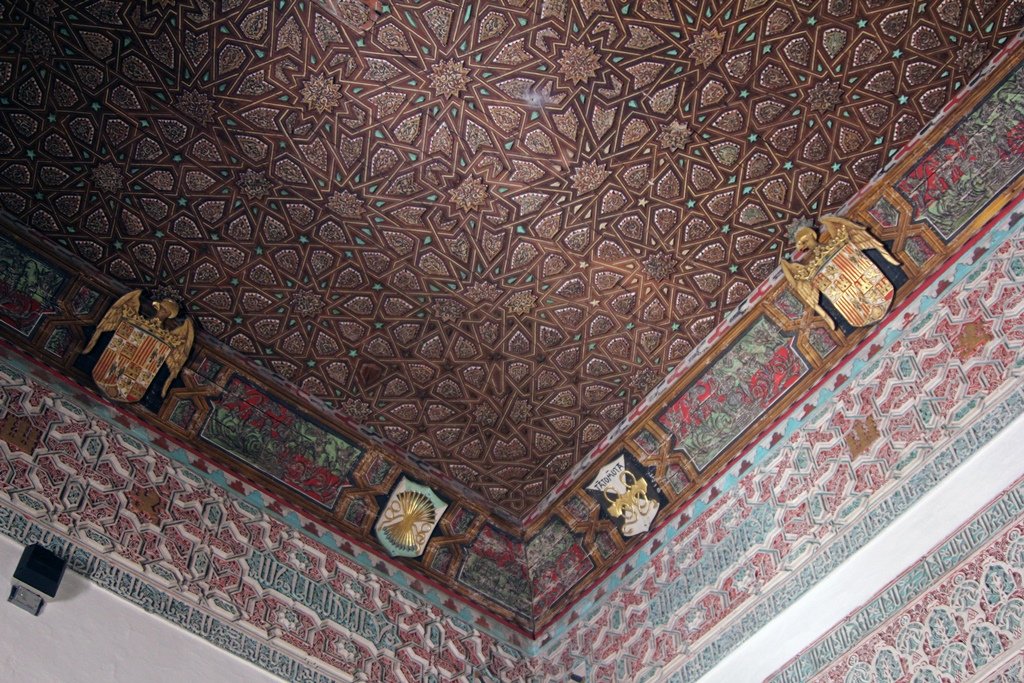
Ceiling, Catholic Monarchs' Room
The most luxurious room in the palace, used as a throne room by Pedro and his successors, is
called the Hall of the Ambassadors. It has a view of the Damsels' Courtyard’s reflecting pool
through an archway, and is surrounded on its other three sides by triple "horseshoe" arches.
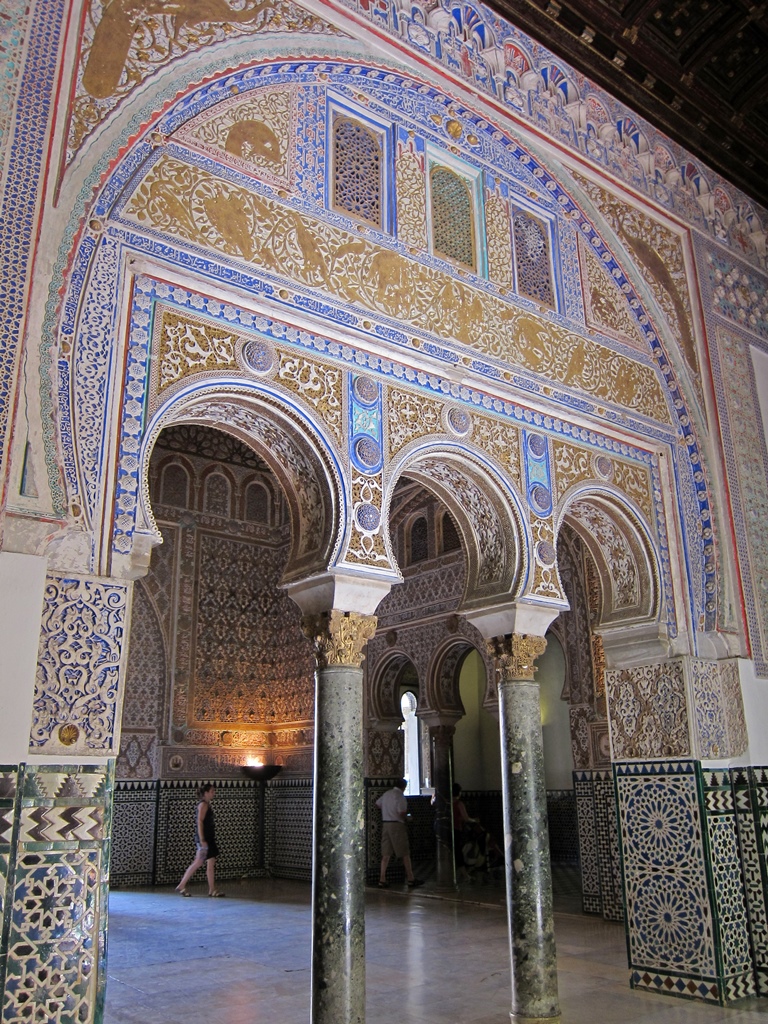
The "Peacock Arch"
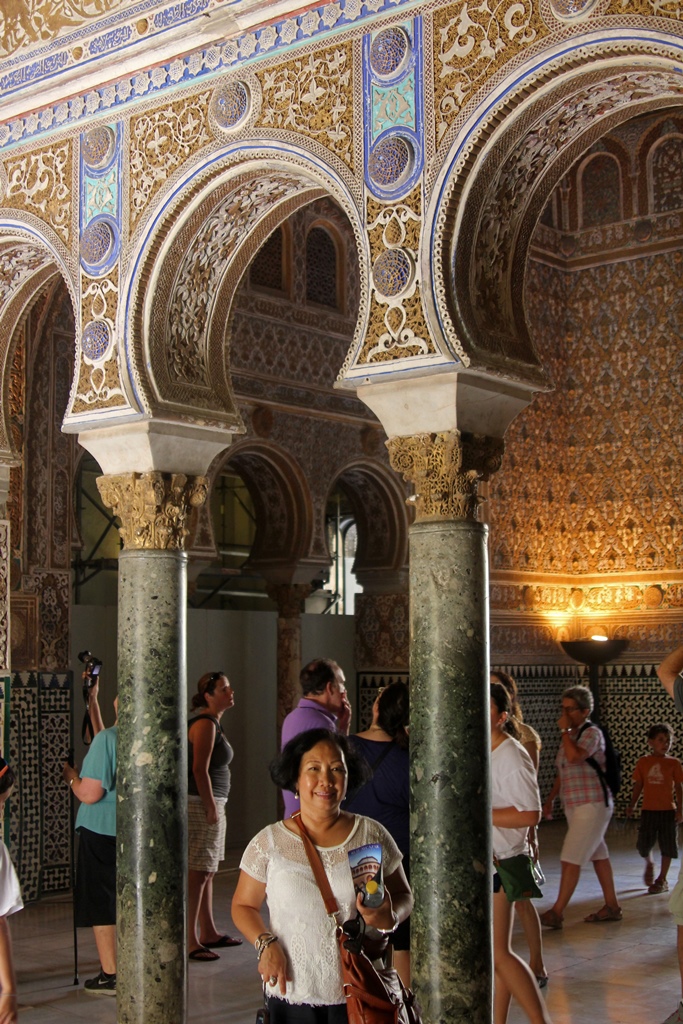
Nella and Peacock Arch

Archway, Hall of the Ambassadors

Corner, Hall of the Ambassadors
Ceiling, Hall of the Ambassadors
A small doorway connects Pedro's palace to the next palace over, the Gothic Palace. This was
the first palace built by Seville's Christian conquerors, replacing a Moorish palace that had
stood on the site. It was not built by Seville's conquering monarch, Ferdinand III, but by his
son, Alfonso X, in 1254, six years after the conquest. It was built in the Gothic style (hence
the name), which was fashionable at the time. Possibly influenced by Moorish ideas, its builders
made use of decorative tiles.

Gothic Palace Chapel - Virgin of Antigua

Wall Tile, Gothic Palace Chapel
There are several tapestries in the Gothic Palace, divided between two rooms, called the Vault
Room and the Tapestry Room. The map tapestry shown below may not ring any bells geographically,
but if you imagine it turned upside-down, it appears to represent the western Mediterranean Sea
(and a little of the Atlantic).
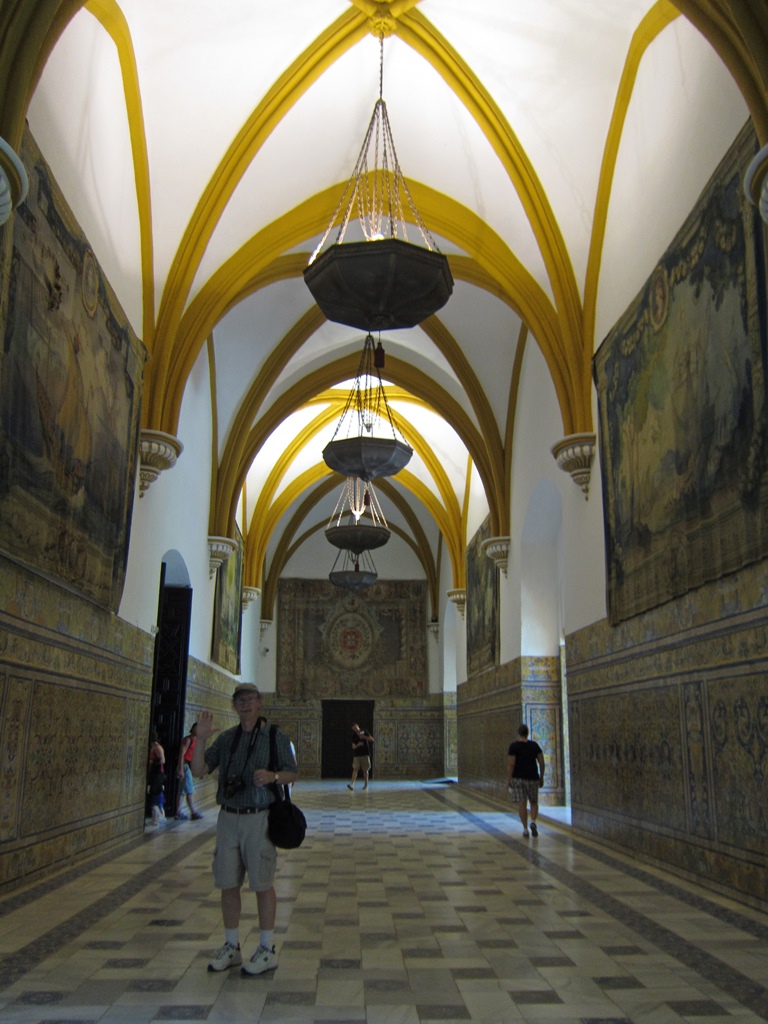
Bob in Vault Room, Gothic Palace
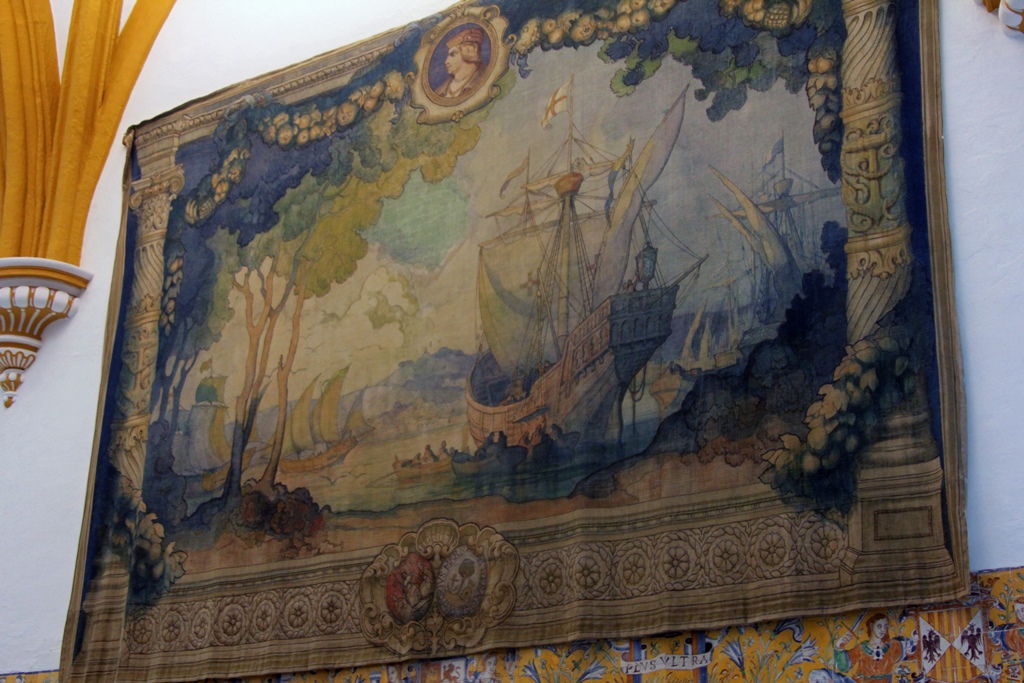
Tapestry, Vault Room
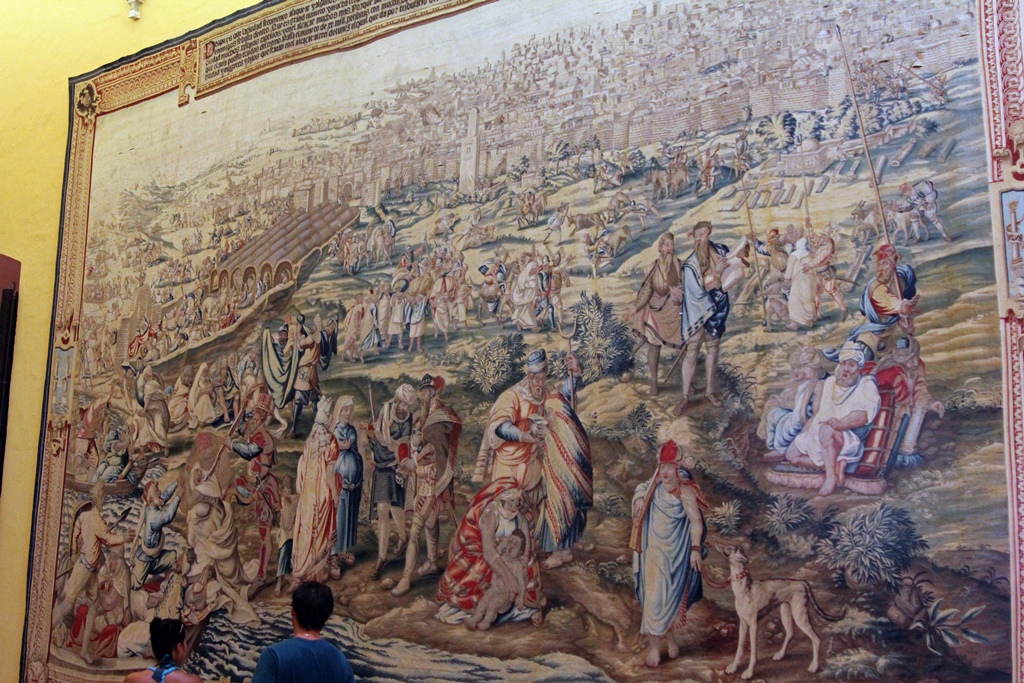
Tapestry with Walled City, Tapestry Room
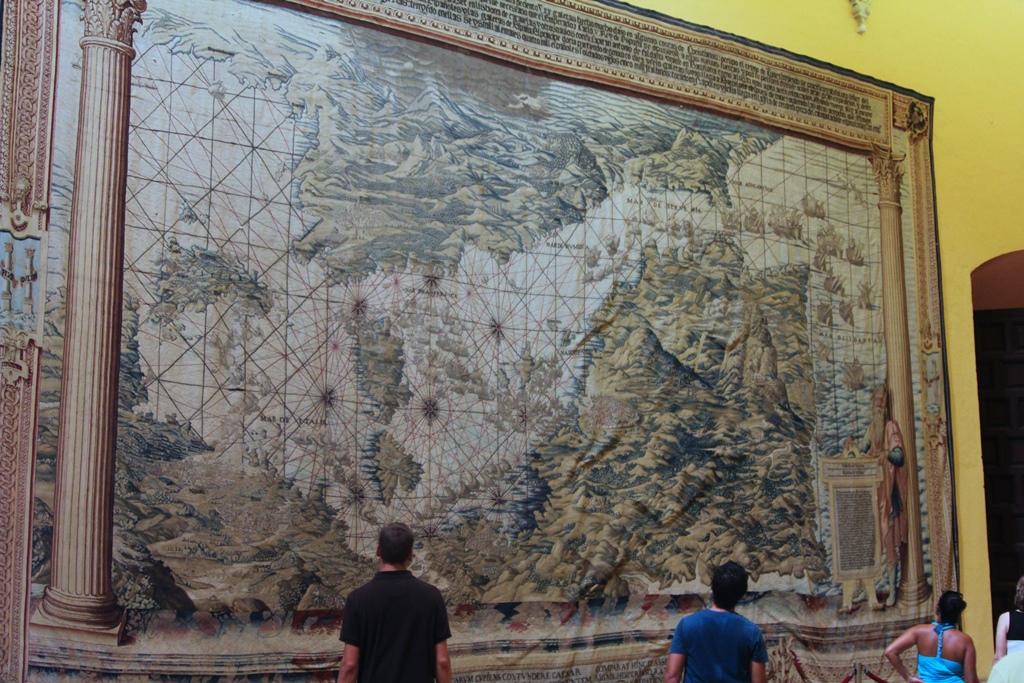
Map Tapestry, Tapestry Room
Exiting the Gothic Palace took us out into the Alcázar's gardens (and into the blistering summer
heat). The first gardens encountered were small and lined up along the outside of the Gothic and
Pedro Palaces. They were done in the early 17th Century in the Mannerist style by architect
Vermondo Resta.

Arcade, the Prince's Garden
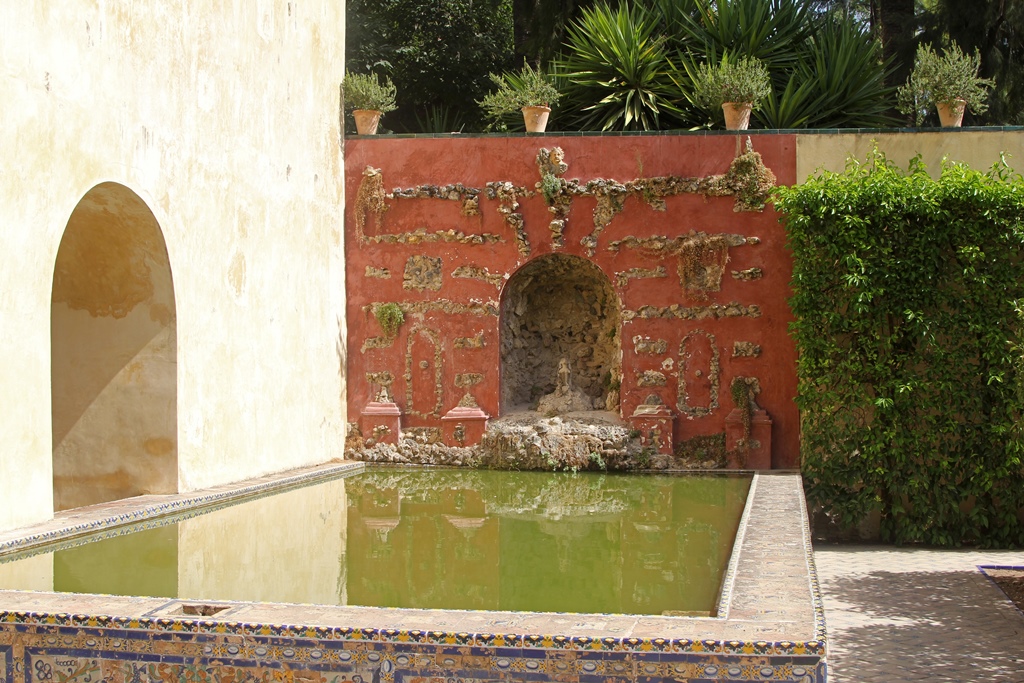
Grotto Fountain, Flower Garden
Alcove, Dance Garden
At the end of these gardens is the Pond Garden, consisting of a large pool (stocked with some
kind of fish) with a small bronze statue of Mercury in the middle. A stream of water falls into
the pool from a pipe atop the second story of an arcade on the north side of the pool. Along the
east side of the pool is a wall called the Grotto Gallery which contains a walkway within its
upper level.
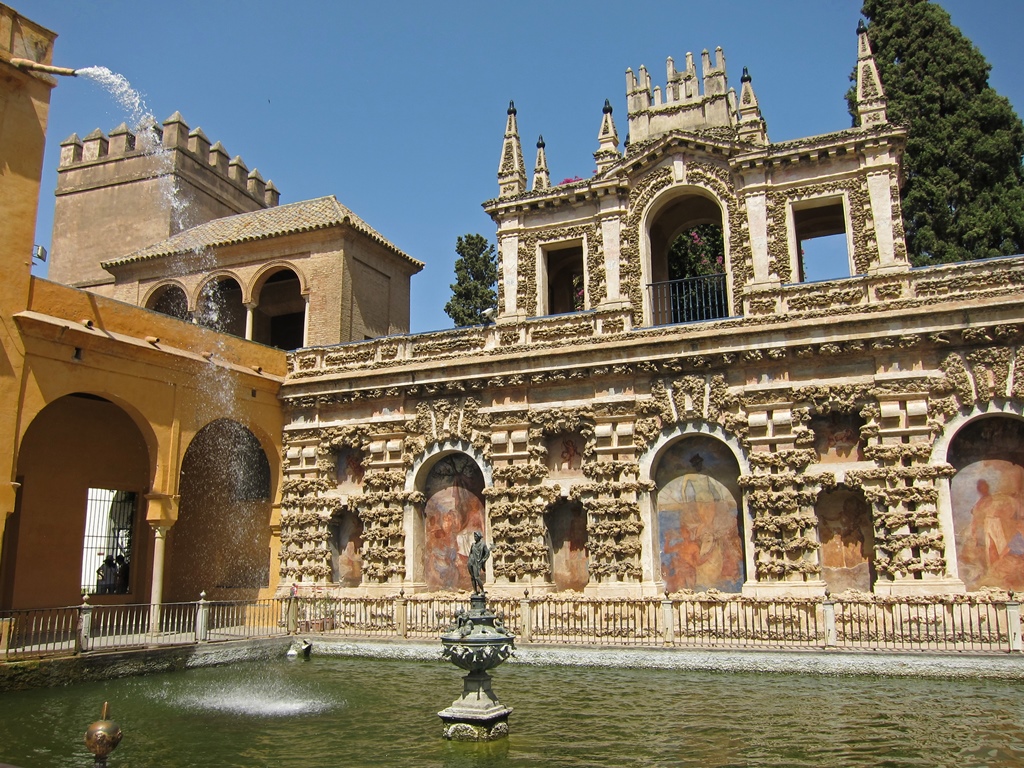
The Pond Garden
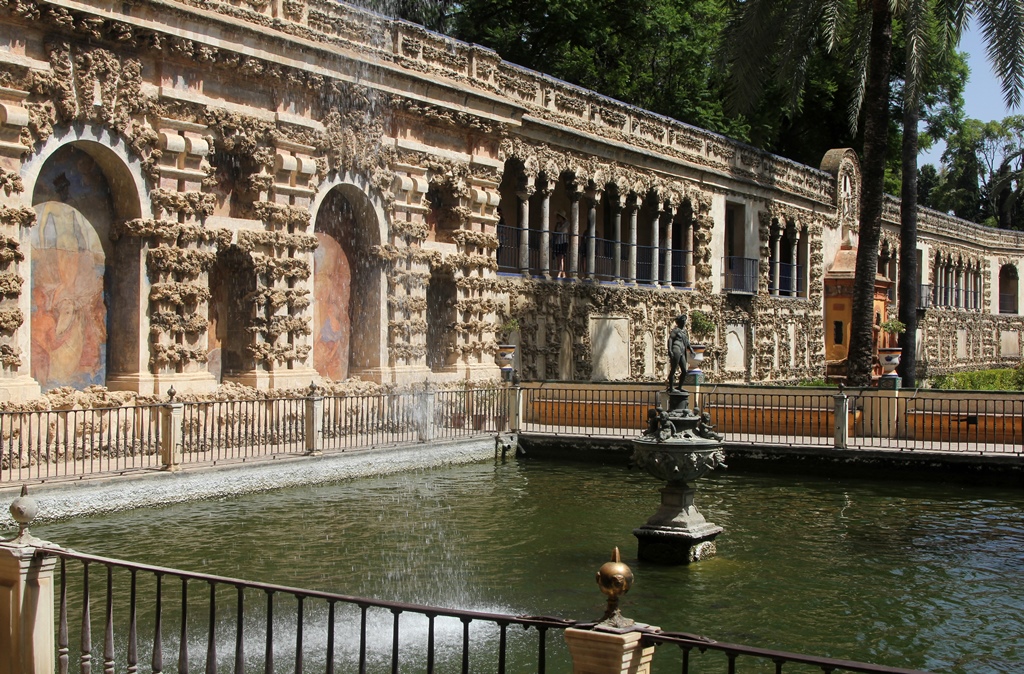
The Pond Garden
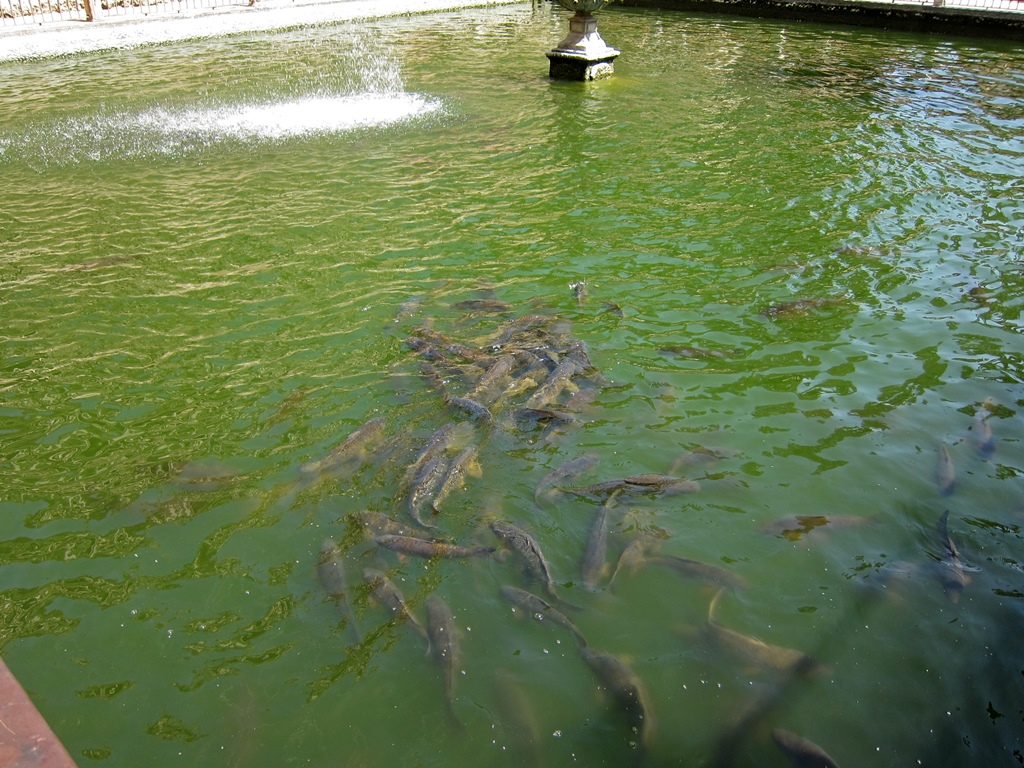
Pool with Fish, Pond Garden

Pond Garden from Gallery
The Grotto Gallery extends out into additional gardens. Viewable from its walkway are the
Damsels' Garden and the Alcove Garden.
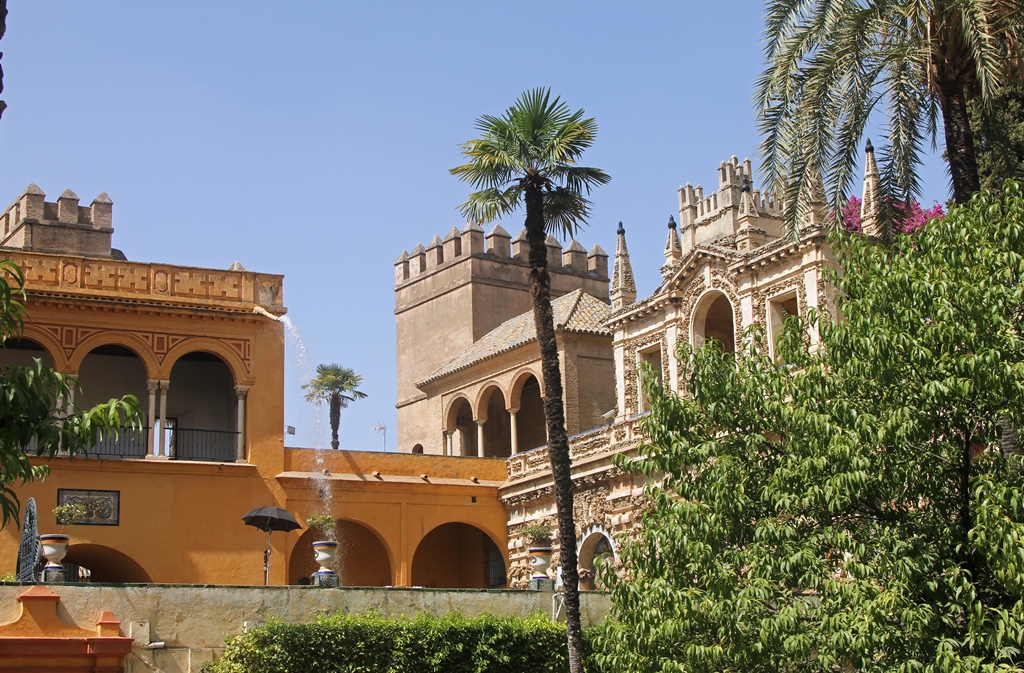
Alcázar from Damsels' Garden
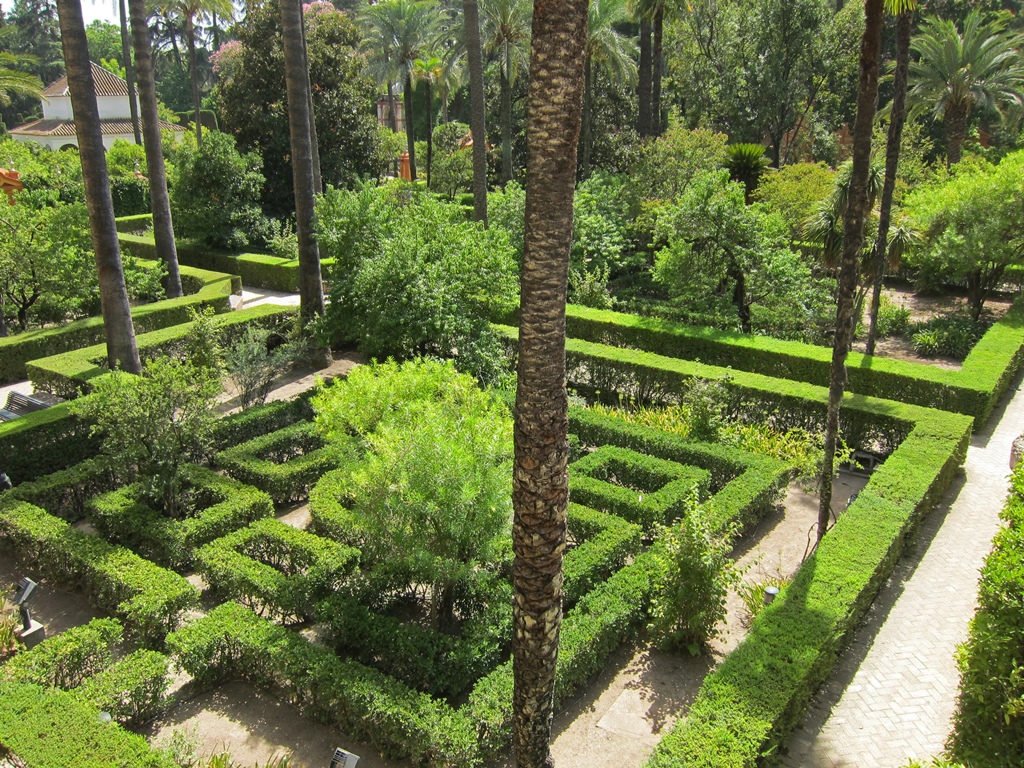
Hedges, Damsels' Garden
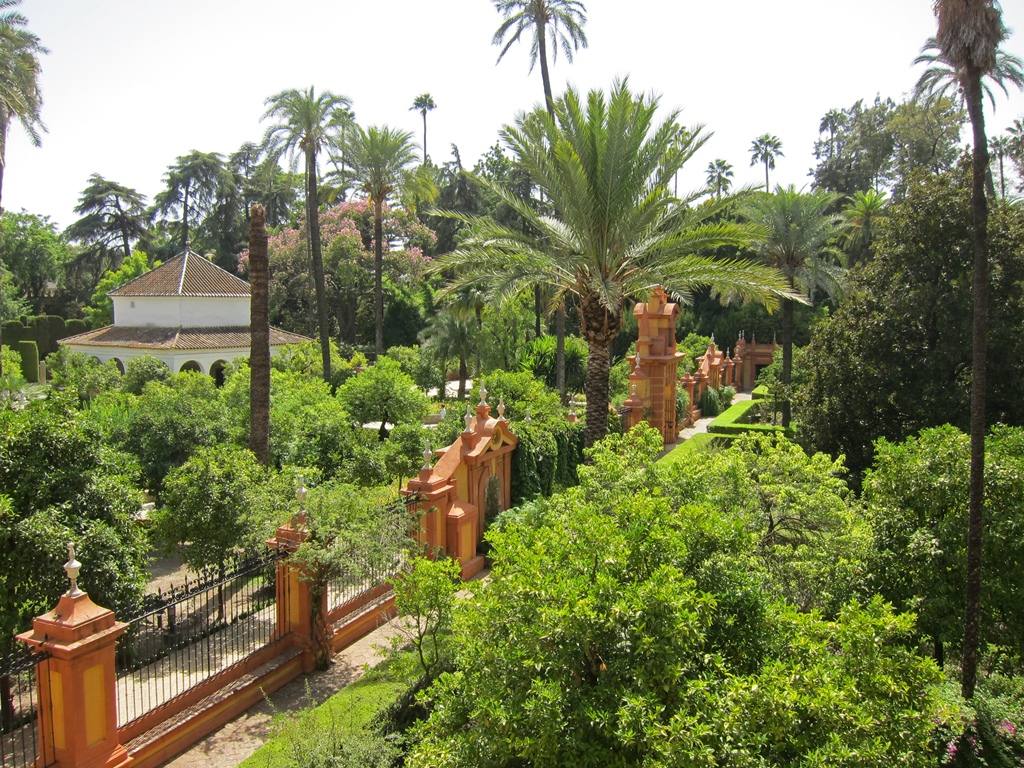
Fence Between Damsels' Garden and Alcove Garden

Charles V Pavilion, Alcove Garden
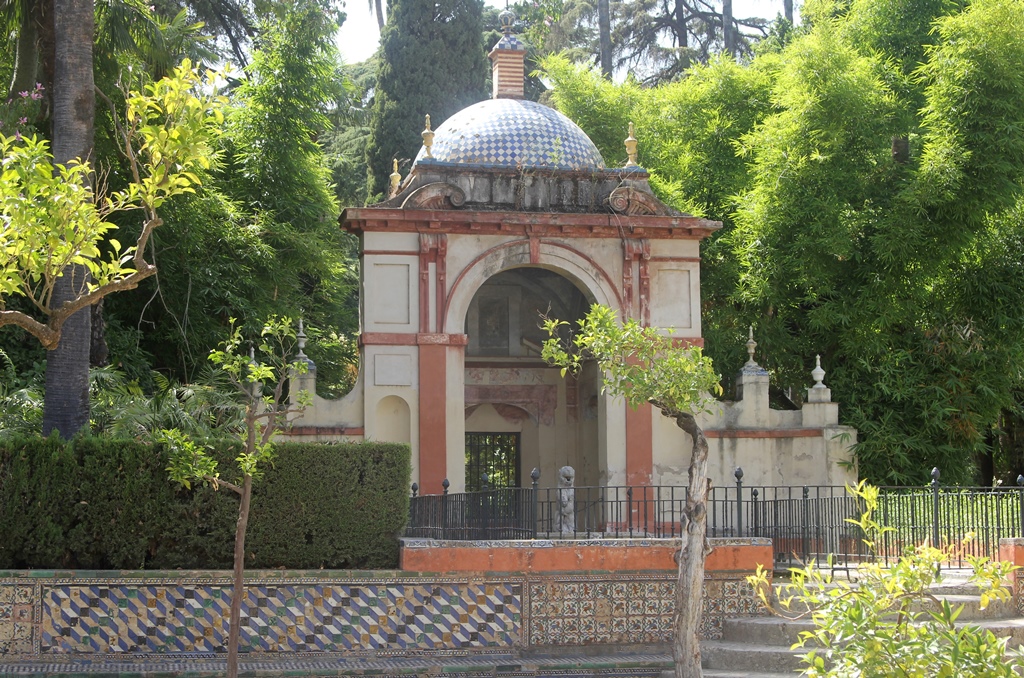
The Lion Bower, Alcove Garden

Philip at Lion Bower, Alcove Garden
On the other side of the Grotto Gallery are additional gardens which are heavier on plants
and trees and lighter on man-made structures.
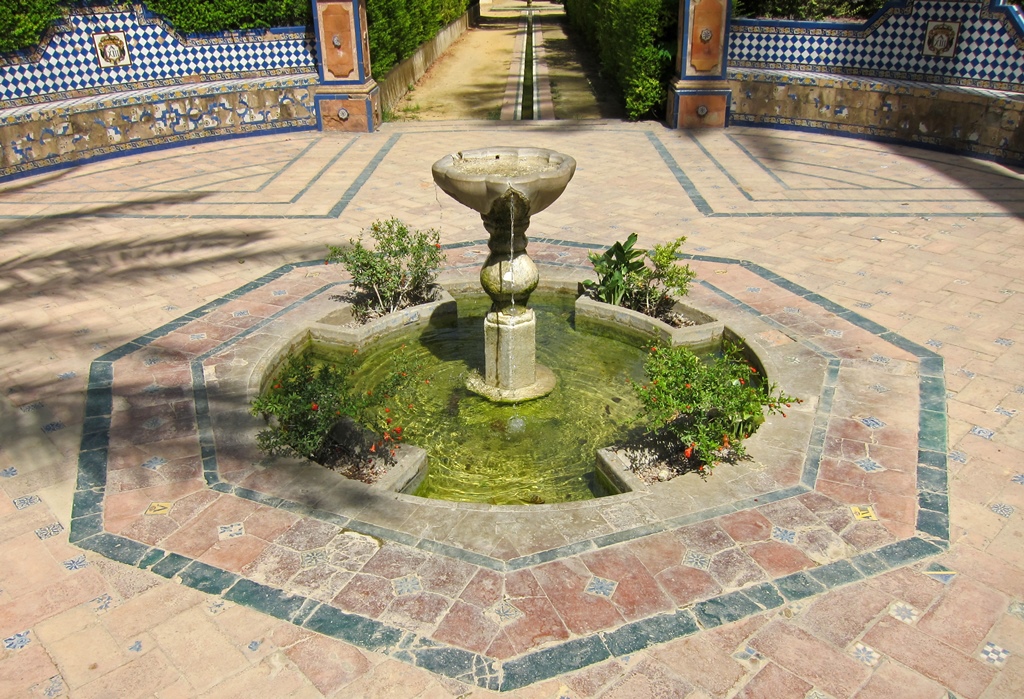
Fountain, Marquis' Garden of Retreat
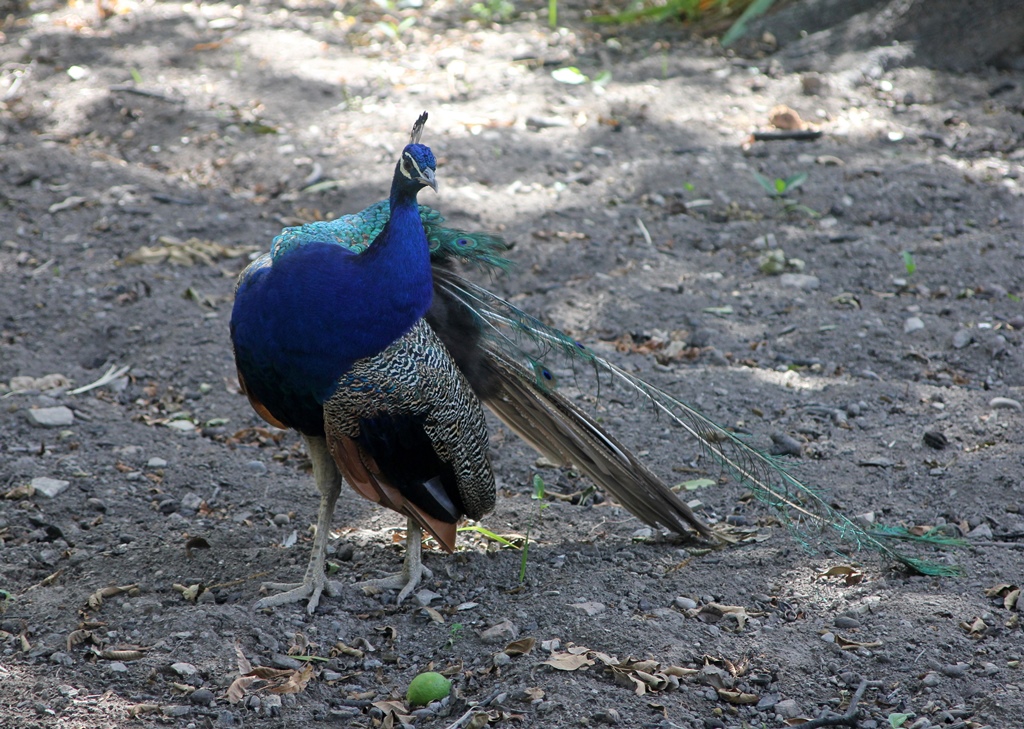
Peacock, Poets' Garden
Monte Parnaso, The Cross Garden
Having had enough of the Water Gardens of Dorne, we headed back through the Gothic Palace
toward the exit into the Plaza del Triunfo.
Bob and Philip and Giralda
We returned to our hotel and rested for a while, wrung out from the exertion and the heat of the
day. Eventually we decided to get up and explore a little more, as this was our only full day
in Seville. Our hotel was not far from a bridge over the Guadalquivir called the Puente de Isabel
II. This bridge leads to a neighborhood called the Triana, which we explored for a little while.
Golden Tower (Torre del Oro) from Puente de Isabel II
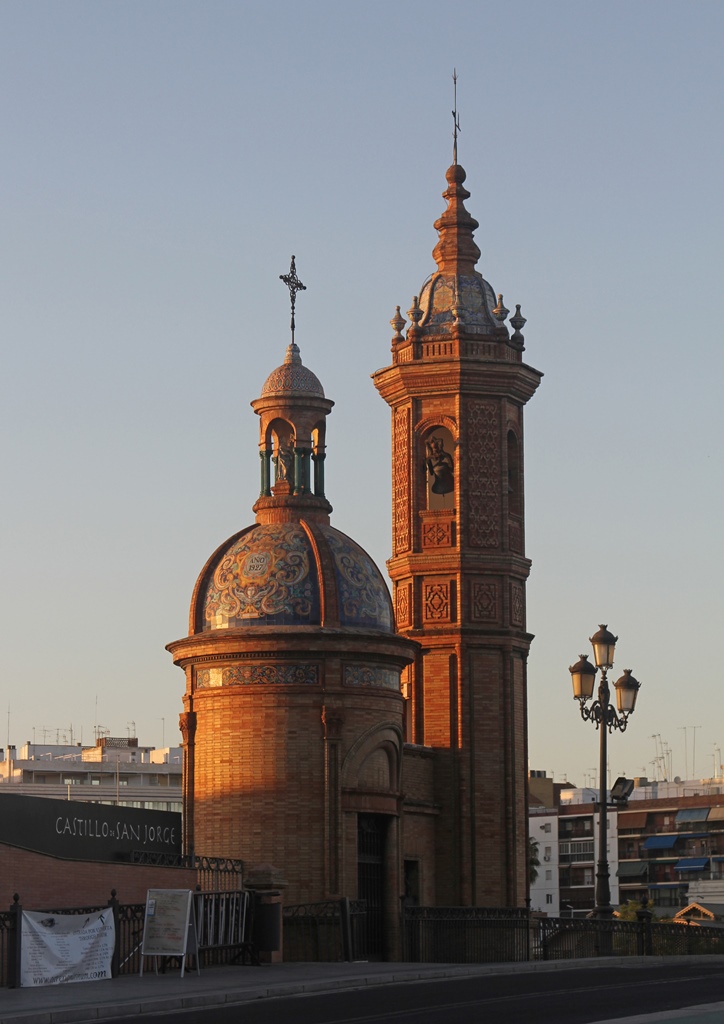
Capilla Virgen del Carmen
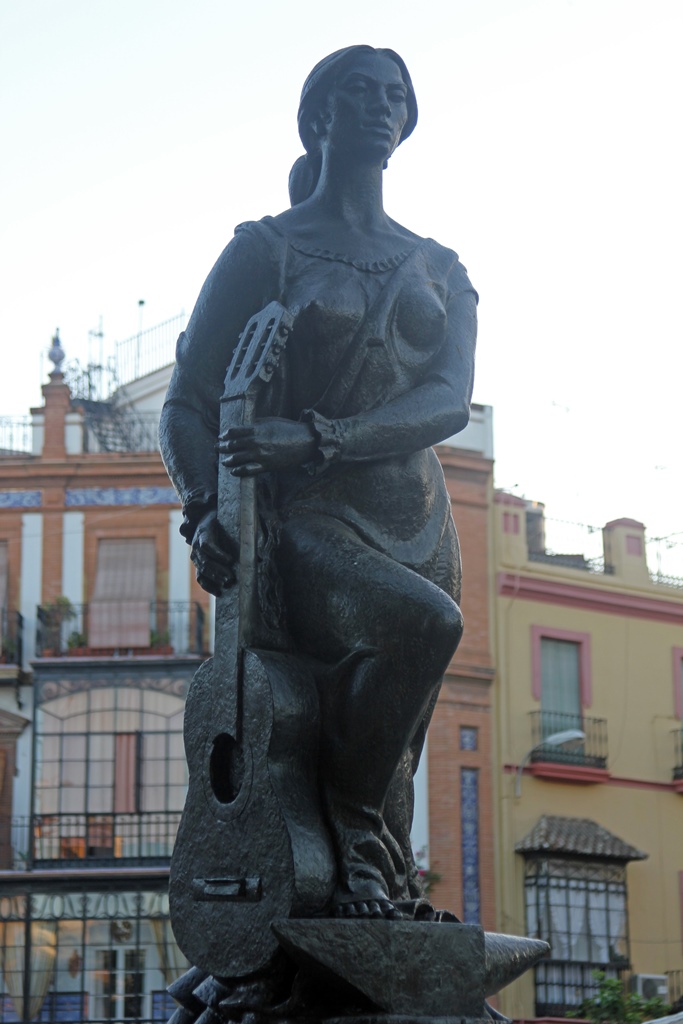
Arte de Flamenco Monument, Triana
Cathedral from Across River
It didn't take us long to get tired again, so we returned to the hotel side of the river and found
dinner. We returned to the hotel and packed for departure (we'd had a lot of practice at this of
late). But there was one more thing we wanted to do in Seville before leaving, which we planned on
doing the following morning: a close-up examination of a peculiar Seville structure called the
Metropol Parasol.


